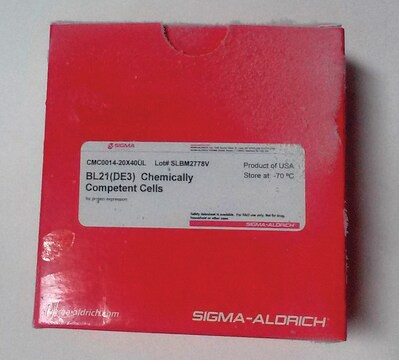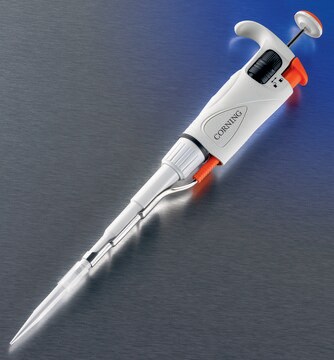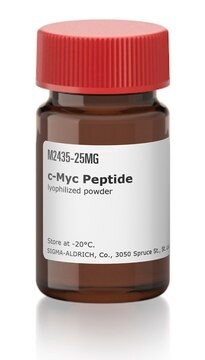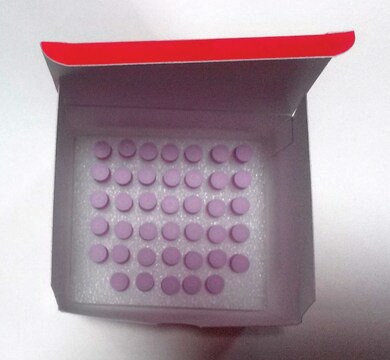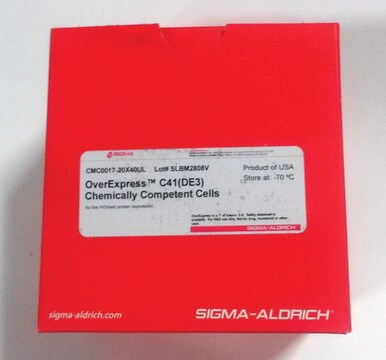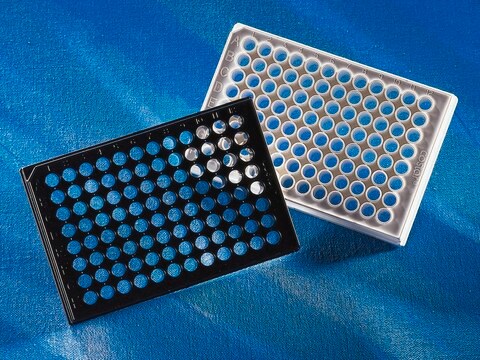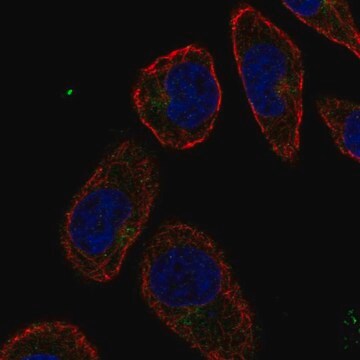CMC0021
OverExpress™ C41(DE3) Electrocompetent Cells
Escherichia coli, rod shaped
Faça loginpara ver os preços organizacionais e de contrato
About This Item
Código UNSPSC:
12352200
NACRES:
NA.85
Produtos recomendados
Nome do produto
OverExpress™ C41(DE3) Electrocompetent Cells, for the highest protein expression
fonte biológica
Escherichia coli
grau
for molecular biology
modo de crescimento
adherent or suspension
morfologia
rod shaped
técnica(s)
microbiological culture: suitable
transformação celular
competent cell type: electrocompetent
transformation efficiency: ≥1 x 109 cfu/μg
Condições de expedição
dry ice
temperatura de armazenamento
−70°C
Descrição geral
OverExpress™ Electrocompetent and Chemically Competent Cells are E. coli strains that are effective in expressing toxic proteins from all classes of organisms, including eubacteria, yeasts, plants, viruses, and mammals. The effectiveness of these new strains in expressing toxic proteins has been validated in more than 350 publications. The OverExpress™ strains contain genetic mutations phenotypically selected for conferring tolerance to toxic proteins. The strain C41(DE3) was derived from BL21(DE3). This strain has at least one mutation, which prevents cell death associated with expression of many recombinant toxic proteins. The strain C43(DE3) was derived from C41(DE3) by selecting for resistance to a different toxic protein and can express a different set of toxic proteins to C41(DE3). OverExpress™ C41(DE3)pLysS and C43(DE3)pLysS also carry a chloramphenicol-resistant plasmid that encodes T7 lysozyme, which is a natural inhibitor of T7 RNA polymerase. Cells containing pLysS produce a small amount of T7 lysozyme. These strains are used to suppress basal expression of T7 RNA polymerase prior to induction, thus stabilizing recombinants encoding particularly toxic proteins.
Genotype
F – ompT hsdSB (rB- mB-) gal dcm (DE3)
Genotype
F – ompT hsdSB (rB- mB-) gal dcm (DE3)
Características e benefícios
- Express genes cloned into any T7 vector with these BL21(DE3) derivatives
- Effective in expressing toxic & membrane proteins
- Cited in over 350 research articles
Componentes
- OverExpress C41(DE3) electrocompetent cells
- pUC 19 transformation control DNA
- recovery medium for expression
Informações legais
OverExpress is a trademark of Imaxio, S.A.
produto relacionado
Nº do produto
Descrição
Preços
Código de classe de armazenamento
10 - Combustible liquids
Escolha uma das versões mais recentes:
Já possui este produto?
Encontre a documentação dos produtos que você adquiriu recentemente na biblioteca de documentos.
Ramachandra M Bhaskara et al.
Nature communications, 10(1), 2370-2370 (2019-05-31)
FAM134B/RETREG1 is a selective ER-phagy receptor that regulates the size and shape of the endoplasmic reticulum. The structure of its reticulon-homology domain (RHD), an element shared with other ER-shaping proteins, and the mechanism of membrane shaping remain poorly understood. Using
Myles B C Dillon et al.
ACS chemical biology, 7(7), 1198-1204 (2012-04-18)
Protein arginine methyltransferases (PRMTs) catalyze the posttranslational methylation of arginine using S-adenosylmethionine (SAM) as a methyl-donor. The PRMT family is widely expressed and has been implicated in biological functions such as RNA splicing, transcriptional control, signal transduction, and DNA repair.
Ji-Young Youn et al.
Molecular biology of the cell, 21(17), 3054-3069 (2010-07-09)
BAR domains are protein modules that bind to membranes and promote membrane curvature. One type of BAR domain, the N-BAR domain, contains an additional N-terminal amphipathic helix, which contributes to membrane-binding and bending activities. The only known N-BAR-domain proteins in
Myles B C Dillon et al.
The Journal of biological chemistry, 288(39), 27872-27880 (2013-08-16)
Protein arginine methyltransferase (PRMT) 8 is unique among the PRMTs, as it has a highly restricted tissue expression pattern and an N terminus that contains two automethylation sites and a myristoylation site. PRMTs catalyze the transfer of a methyl group
Neale Harrison et al.
PloS one, 9(11), e113007-e113007 (2014-11-26)
N-acylethanolamines are an important class of lipid signaling molecules found in many species, including the nematode Caenorhabditis elegans (C. elegans) where they are involved in development and adult lifespan. In mammals, the relative activity of the biosynthetic enzyme N-acyl phosphatidylethanolamine-specific
Protocolos
OverExpress™ Electrocompetent Cells are provided in 25 μL aliquots, sufficient for one transformation reaction.
Nossa equipe de cientistas tem experiência em todas as áreas de pesquisa, incluindo Life Sciences, ciência de materiais, síntese química, cromatografia, química analítica e muitas outras.
Entre em contato com a assistência técnica
